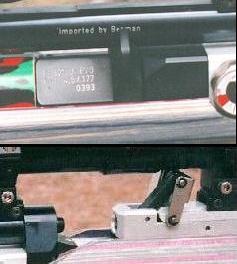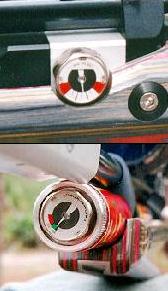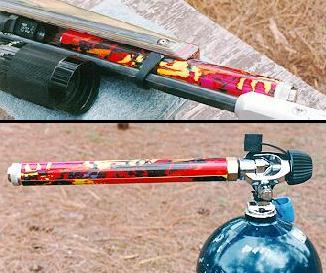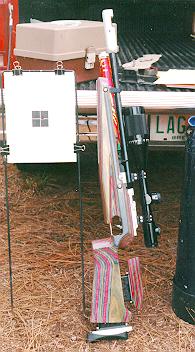
The Beeman/FWB P70 Field Target Air Rifle
By Brad TroyerOriginally Published in 1997

click the ad to visit this advertiser, View All Advertisers On This Page
I am pretty skeptical when it comes to hype and claims about new products whether they be airguns, electronics, cars, or anything else. When I first started hearing about the new Feinwerkbau P70 FT I thought to myself, I'll believe it when I see it. After all, the rumors going around included 3/8-1/2" groups at 50 yards, a lock time so low that it seemed almost instantaneous, and no zero shift problems. Well, after this review I can say that I believe it!
The standard Beeman/FWB P70 is new precharged match airgun line that includes a 10 meter rifle and a running target rifle. The FWB P70 Field Target is a combination of the these two guns. It was developed by Mance Etheredge and it combines the barrel and action from the P70 Running Target with the stock and trigger unit from the 10 meter rifle. The only other changes that were made to achieve the P70 FT is the addition of a regulator extension, a shim to the striker spring, and widening of the transfer port. That's it. This combination on the gun I tested worked very well.

I first saw the P70 in Baton Rouge at the 1997 U.S. Field Target Nationals. It was an impressive looking rifle! There was quite a buzz about it among the shooters there. I got to shoot with the P70 for a short time the day before the match. I was really impressed that day and even more impressed when I got back home and put the gun to the test. The P70 is very well balanced, smooth shooting gun. Bringing it into the classic field target sitting position, I felt very comfortable behind the rifle. As I became more familiar with the rifle and the NightForce 36X Field Target scope that came with it, I found that it was fairly easy to shoot 3/4" groups on my 50 yard target.
The P70 is by far the most accurate rifle I have every shot. The accuracy statistics bare this out. Off a bench, outdoors, I was able to get 1/2-3/4" groups regularly with lubricated pellets right out of the box! I shot a few groups less than 1/2", but shooting outdoors made these groups the minority. I have heard of similar groups from few others that have shot the P70. In fact, I gave the rifle I tested to Bob Peiser after I was done testing it. He shot it at John Giles indoor range and shot one 10 shot group that was a perfect 3/8" circle, measured from outside to outside! He told me that he averaged 1/2" & 5/8" groups pretty regularly with sorted pellets.
| Crosman Premiers 7.9 |
Crosman Premiers 10.5 |
Beeman Kodiak Match |
Beeman Trophies | |
|---|---|---|---|---|
| Average Accuracy | 0.6875 | 0.54375 | 0.525 | 0.8125 |
| Lowest | 0.5 | 0.4375 | 0.4375 | 0.5 |
| Highest | 0.875 | 0.625 | 0.625 | 1.0 |
One reason the P70 is so accurate is the consistency of the velocity from shot to shot. Both the Beeman Kodiaks and Crosman Premiers 10.5 pellets maintained a standard deviation under 2.25 fps. The P70 I tested was tuned in Colorado to shoot the Crosman Premiers 10.5 pellets at 800 fps. They register a bit lower here in Florida. The P70 can be adjusted to higher power if this is what the shooter desires. The lower power didn't hurt the performance at all. I shot the P70 at one of my club matches. Except for two shots that I flinched on, I cleaned the course.
| Crosman Premiers 7.9 |
Crosman Premiers 10.5 |
Beeman Kodiak Match |
Beeman Trophies | |
|---|---|---|---|---|
| Average Velocity | 875.3 | 787.9 | 808.6 | 877.4 |
| Standard Deviation | 2.64 | 2.14 | 2.18 | 3.36 |
| Highest | 881 | 792 | 812 | 884 |
| Lowest | 872 | 784 | 803 | 872 |
| Extreme Spread | 9 | 8 | 9 | 12 |
| Energy | 13.44 | 14.48 | 15.25 | 13.34 |
Shooting good groups with the P70 is due partly to it's excellent accuracy. Another big reason is the very low lock time. I started to really notice the lock time when I started plinking during my testing. I sat down and sighted in at 50 yards. When the trigger broke, I noted where the crosshairs were on the target. To my surprise, the pellets were landing at the last position I saw the crosshairs. One reason for the short locktime is due to the short stroke. This is the distance the striker must move to impact and knock open the valve. Most other precharge guns have about a 12 mm travel while the P70 has only a 3.7 mm travel. The shorter 16.6" barrel also contributes to the short lock time.
I was eager to try out the P70 with some field targets. I started with a 1 1/2" and 1" kill zone target at 50 yards. I quickly tired of these as they were too easy. I tried my luck with a 1/2" and 3/4" at the same distance. I was able to hit the 3/4" target 8-9 times out of ten and the 1/2" about 5-6 times. I found that as the crosshairs started to move across the kill zone I could squeeze the trigger and the target would fall. The pellet hit shot where the gun was pointed, it was great!
The P70 has two stocks available for it, a standard laminated wood stock and a multicolored stock. There was one of each at the Nationals and both were very handsome. The stocks are 10 meter stocks which means they are adjustable every way to Sunday. The check piece can be moved up and down 30mm, canted top to bottom or bottom to top by 20 degrees, canted left to right 15 degrees, and the entire unit can be moved 5mm left or right. The butt plate has a similar range of motion. Basically, this gun can be made to fit just about any shooter.

The stock was designed for 10 meter match shooting, but I found it to also be well suited for field target shooting. The stock is flat and wide for about 7 inches in front of the trigger. With the adjustable cheek piece and butt plate, I had no problem bringing up the rifle into a steady hold shot after shot. The only thing I might change is the rollover on the cheek piece. I found the top edge pushed into my cheek a bit more than I liked. But, I spoke to a couple other shooters that have a P70 and they told me that they didn't notice it at all, so it may just be me and the way I hold the rifle.
The P70 is a well balanced and heavy gun. The gun by itself weight about 10 lbs, and with the scope, well, it's heavy. I personally liked the weight. It helped to steady the gun and with it being so well balanced, it didn't seem that heavy to me shooting it. The P70 also comes with a set of barrel weights and a stock weight that allows the shooter to customize the balance and weight to their individual liking. The P70 I shot didn't have the stock weight and I removed the barrel weights. This combination seemed to work very well for me.
Feinwerkbau air rifles are known to have some of the finest triggers and barrels, and the P70 is no exception. The barrel is 16.6 inches long and it is surrounded by a barrel shroud. The shroud is threaded at the end to allow the barrel weight set to be screwed on and off. And the trigger? It was fantastic. The P70 trigger is adjustable from 3.5 ounces to a little more than a pound. There are adjustments for pull-off point, initial travel, finger length, lateral position, and trigger slack weight. The P70 I shot had the trigger adjusted to break at 2 ozs. It was very clean and crisp and everything that I expected from a Feinwerkbau.

Most other precharged are cocked via a bolt type arrangement. The P70 uses a slide set in front of the loading port. Pushing the slide forward with either thumb (the slide is present on both sides of the rifle) sets the trigger, charges the gun, and opens the loading port. With the loading port open, the pellet could be easily inserted. The whole loading port area was open enough to allow excellent visibility and easy pellet loading. I liked to hold the rifle upward while I loaded it and occasionally I would drop the pellet down into the grooves that the loading port slides on. When I angled the barrel down to roll the pellet forward, the loading port would slide forward and the pellet would get jammed in between the groove and loading port. This was easily fixed my holding the loading port while trying to retrieve the dropped pellet.
The P70 also has a very handy dry firing mechanism. Simply cock the rifle and leave the breech open. The rifle can then be dry fired. Cocking the gun again resets the trigger and it is ready for continued practice or loading and shooting.
To make this gun practical for field target, the power had to be increased. Shooting 570 fps just won't cut it. A regulator extension had to be added to increase the number of shot per fill with the increased power. The P70 I shot was getting 55-60 usable shots per fill at 800 fps. This was due partly to the regulator extension and the self regulating valve that comes standard on the rifle. Across the chronograph, the velocity seemed to drop around 10-15 fps and I naturally thought this to be the shot limit. However, there was no significant impact change noticed. In fact, the last groups were as tight as the first groups. Since most field target matches are typically 40 shots or less, there is plenty of air in the reservoir to complete an average match.

The regulator extension also has a very handy gauge on it that allows you to see what the pressure level is at a glance. The gauge is on the left side of the action just forward of the loading port. As a right handed shooter, I can see the gauge every time I load a pellet. This is helpful during a practice or plinking session so that I didn't waste any pellets.
The air reservoir also has a gauge on the end of it. If you aren't sure how much air you have left by looking at the regulator gauge, you can check the reservoir gauge. I found it to be very accurate. When the needle on the gauge dropped into the red shaded area below the 100 bar mark, it was time to refill. Refilling was very easy too. Simply unscrew the reservoir and slide it forward to remove it from the rifle. I liked this since the rifle can stay pointed in a safe direction filling the reservoir. It can then be screwed into the filling adapter. filling adapter doesn't have a gauge on it since you can use the gauge on the the reservoir. I usually filled it to 200 bar. To re-install the reservoir, cock the rifle, slide it back under the barrel, and screw it on tight. You must remember to cock

the rifle before installing the reservoir. When the reservoir is removed, the striker holds the valve open, so when you install the reservoir air will drain out through the barrel. It only takes once or twice of this happening before you remember to do it every time. I started cocking the rifle before I removed the receiver. This made the gun safe and I didn't have to worry about remembering to cock it.
The P70 I tested was a very solid, well built, accurate air rifle. I normally try to be critical about the rifles I test. It was hard to find much I didn't like about the P70. It may just be the ultimate Field Target rifle available today. It won't work miracles, but for the average shooter it should help you increase your score. If the P70 can withstand the test of time, it has the potential of being one of the finest Field Target rifles ever.
Note to the Reader: This review was written in 1997. Mance Etheridge no longer converts the P70 to high power. If you are interested in a P70FT, contact Beeman Precision Airguns.

click the ad to visit this advertiser, View All Advertisers On This Page
Beeman/FWB P70 FT Specs

| Model | Beeman/FWB P70 FT |
|---|---|
| Manufacturer | Feinwerkbau Germany |
| Sold By: | Beeman Precision Airgun |
| Type | Pre-charged Pneumatic |
| Power Source | detachable air reservoir |
| Caliber | .177 |
| Energy | 15 ft. lb. |
| Overall Length | 41" |
| Weight | 10 lbs. |
| Barrel | 16.6", 1:12 twist |
| Sights | None |
| Stock | Laminated Wood, Multicolored Laminated |
| Safety | None |
| Trigger | 2 stage match adjustable |
Back to Review Page
Back to American Airgun Home
Top of Page

click the ad to visit this advertiser, View All Advertisers On This Page
© Copyright 2006 by Brad Troyer & American Airguns


